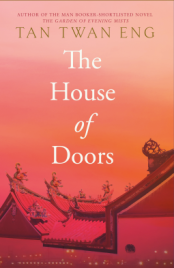 About the Book
About the Book
It is 1921 and at Cassowary House in the Straits Settlements of Penang, Robert Hamlyn is a well-to-do lawyer and his steey wife Lesley a society hostess. Their lives are invigorated when Willie, an old friend of Robert’s, comes to stay.
Willie Somerset Maugham is one of the greatest writers of his day. But he is beleaguered by an unhappy marriage, ill-health and business interests that have gone badly awry. He is also struggling to write. The more Lesley’s friendship with Willie grows, the more clearly she sees him as he is – a man who has no choice but to mask his true self.
Format: eARC (320 pages) Publisher: Canongate
Publication date: 18th May 2023 Genre: Historical Fiction
Find The House of Doors on Goodreads
Purchase links
Bookshop.org
Disclosure: If you buy a book via the above link, I may earn a commission from Bookshop.org, whose fees support independent bookshops
Hive | Amazon UK
Links provided for convenience only, not as part of an affiliate programme
My Review
I loved both of Tan Twan Eng’s previous books – The Gift of Rain and The Garden of Evening Mists – but, boy, has he made us wait a long time for his next one. It’s been well worth the wait though because The House of Doors is absolutely brilliant. In fact, I wouldn’t be surprised to see it pop up on the longlist for next year’s Walter Scott Prize for Historical Fiction.
Set in Penang (the author’s birthplace) and moving beween 1910 and 1921, it’s an intimate and nuanced portrait of the complications and consequences of relationships that must remain clandestine, such as that between Willie Somerset Maugham and Gerald Haxton, nominally his secretary but actually his lover.
The book opens in 1947 as Lesley Hamlyn, living on a remote farm in Doomfontein, South Africa, receives a package containing a copy of the book, The Casuarina Tree by W (Willie) Somerset Maugham. It evokes memories of the author’s two week stay in 1921 with her and her late husband, Robert, at Cassowary House, their former home in Penang. It was a place Lesley loved and was reluctant to leave but did so out of a mixture of loyalty to her husband, and despair. The book also has another significance for Lesley, one which the reader will only discover in the moving final chapter of the book.
Willie arrives in Penang in 1921 weakened by sickness from his travels through the Far East and beset by money troubles, a situation he fears may scupper his relationship with Gerald who has become used to a luxury lifestyle. In order to restore his finances, he needs to find material for his next book. Willie and Lesley form an immediate bond, both being in marriages that provide a form of cover from society gossip and speculation. Lesley begins to unburden herself to Willie, sharing details of a secret relationship that took place ten years earlier as well as her involvement with charismatic Chinese revolutionary, Sen Yat-Sen (a real life figure). She also reveals her connection with a (real life) murder case that scandalised the British inhabitants of the Straits Settlement and the Federated Malay States.
Willie uses her recollections as material for the stories in The Casuarina Tree. Reading the published book, and in particular the story ‘The Letter’, Lesley observes that ‘He had woven it into something that was familiar to me, yet also uncanny; factual, but at the same time completely fictional.’ Tan Twan Eng has harnessed the same writer’s instinct to blend historical fact with fiction in order to create this wonderful novel.
Those who have read Tan Twan Eng’s previous novels won’t be surprised that there is wonderful descriptive writing that really brings to life the bustling streets of the ‘real’ Penang, i.e. the Penang that the white residents don’t see. There is also a wonderful scene in which Willie and Lesley go for an evening swim. ‘That night, side by side, we drifted among the galaxies of sea-stars, while far, far above us the asterisks of light marked out the footnotes on the page of eternity.’ Gorgeous.
The House of Doors of the title is an actual place in the novel but is also a metaphor for things that must remain hidden, often things more wonderful than the plain facade shown to the outside world.
I received an advance review copy courtesy of Canongate via NetGalley.
In three words: Assured, intimate, moving
Try something similar: The Chosen by Elizabeth Lowry
 About the Author
About the Author
Tan Twan Eng was born in Penang, Malaysia. His debut novel The Gift of Rain was longlisted for the Man Booker Prize in 2007 and has been widely translated. The Garden of Evening Mists won the Man Asian Literary Prize 2012 and the 2013 Walter Scott Prize for Historical Fiction, and was shortlisted for the Man Booker Prize 2012 and the 2014 International IMPAC Dublin Literary Award. The House of Doors is his third novel. (Photo: Publisher author page)


Penang is on my list of places I really want to visit!
Thanks for sharing this review with the Historical Fiction Reading Challenge!
LikeLike